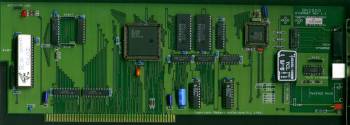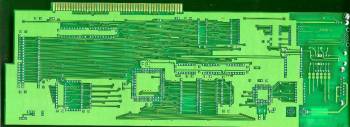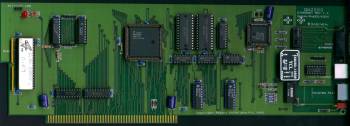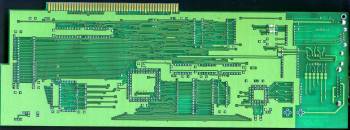
| Resource Management Force: QuickNet |
| Anschluss: Zorro II |


Pictures showing the Quicknet Card (V1.2) with 10Base5 (thicknet) and 10Base2 (thinnet) options


Pictures showing the Quicknet Card (V1.2) with 10Base5 (thicknet) and 10Base2 (thinnet) and rare 10BaseT options
Hi Res Version of Front 10Base2/10Base5 - bytes
Hi Res Version of Back 10Base2/10Base5 - bytes
Hi Res Version of Front 10Base2/10Base5/10BaseT - bytes
Hi Res Version of Back 10Base2/10Base5/10BaseT - bytes
Quicknet review with additional info - bytes
| Type | Ethernet |
| 10Base2 (BNC & Coax, ThinNet): | Yes |
| 10Base5 (AUI & Coax, ThickNet): | Yes |
| 10BaseT (RJ45 & UTP): | Yes |
| 100BaseTX (RJ45 & UTP): | No |
| SANA-II Driver: | Yes (built into ROM) |
| MNI Driver: | Yes (z2-mb86950.mni) |
| Other Driver: | Yes |
The QuickNet card is quite unique amongst Amiga ethernet cards. It contains an EPROM which holds both the SANA-II driver and custom QuickNet networking. You can choose which software you wish to use by selecting a jumper on the back of the card. The QuickNet software is a fast peer-to-peer networking solution designed for Amiga's on an ethernet network and allows hte sharing of drivers etc. It is unclear whether the QuickNet software sits on top of TCP/IP, but this is believed not to be the case. In addition to the software in the EPROM, there is additional software to be installed on the "master-server", which is the machine that is likely to be rebooted the least. You need to install the software only on this machine. The disk-sharing process for all "slave" machines is done completely from the master. Each board has its own "physical" address which is used to recognize the board on the network. Once the "master-server" is completely installed, all the "slave" machines will display a requester when they boot, containing a "username" and a "password" field. The slaves can use any of the drives exported by the server, just as if they were local disks. The device recognises the ".backdrop" icons of the WorkBench 2.x and all the snapshots made. The network is completely transparent to the user! For each user, you may set up different access levels, different configurations, and different shared disks. You should do this only on the "server" machine. If you need to make a machine, you need to change only the configuration of the "master-server" to add the address of the new board in the list. On some diskless machines, you may boot remotely from another machine on the network. You do not need a hard disk in any of the slaves. QuickNet has an ARexx port. It allows you to send ARexx scripts to other machines in the network! You may, for example, pilot a slideshow on all the machines on the network from a single machine. You could also use it in schools so the teacher may run tutorial software on the students' machines, etc. Additional information can be found
The network card itselfs is a full length Zorro II card. The QuickNet software allows remote filesharing between two or more Amigas and actually supports the mounting of drives on another machine, which are themselves network drives (regardless of what protocol they use). The Quicknet Cards contain a switch which allows the ID to be toggled between 1 and 2 (V1.0 cards have 3 IDs). The MNI driver supports both IDs however it is highly recommended that you set it to 2 as this has much better performance. Some versions of the card may be fixed at ID 1 and cannot be changed. The card pictured on this page is version 1.2 which differs slightly from versionb 1.0 cards. As well as having only 2 ID's (V1.0 has 3) it has improved labelling and the part labelled 9-18V is labelled 12-9V on the older card. The number mentioned on the ROM is believed to be the number of QuickNet cards manufactured when it was made. Note: The QuickNet 2000 is available with various support for networking connectors, including all three types (10Base2, 10Base5, 10BaseT) so it depends on the particular card you have as to which connectors may be supported.
Adding UTP Support
If your Quicknet card does not support 10BaseT, you can upgrade the card by soldering the following items to the appropriate areas on the card:
2 x Capacitors
6 x Resistors
1 x PT4059 IC (or equivalent, eg Nan-Pulse or National)
1 x RJ45 Connector.
Quicknet network card
The Quicknet works in all Amigas with Zorro slots ie. A2000, A3000 & A4000
The Quicknet card comes with a 2 way switch on the back.
If you have the newest version of the card this switch does nothing Nb. If you bought the card from MC1 you have the latest version of the card.
Loading the software
1) Uncrunch the Quicknet.lha file Nb. Workbench 3.9 comes with automatic extraction built in.
Copy the quicknet driver (v2.1 dated 1995) to the
dh0:/devs/network directory (or to whichever hard drive you are booting from).
The driver must be called
quicknet.device
otherwise it will not work.
Setting up a TCP/IP stack
Miami (Recommended)
This TCP/IP stack is particularly quick and easy to set up. However any stack should work eg. AmiTCP, etc...
Miami comes standard with WB3.5 or is available free of charge on Aminet. Search Google for Aminet or just go to the http://connect.to/amiga "Links" page which should have a link to the latest version of Aminet.
1) Use the MiamiInit program to set up the stack. It is a largely automated 5 minute process. You should get presented with Quicknet drivers with ID numbers 0-4. Any of them should work but 0 is a logical place to start. Set up your network as per normal: client, gateway, DNS server, etc... Stay with the default Amiga1 machine name unless you have a good reason to change it. If in doubt let Miami use default settings.
2) Save the miamiinit.config file.
3) Run Miami (main program) & import the miamiinit.config file. This is necessary to load the settings correctly.
If it's not working turn off any firewall (or other software that might be interfering) on the gateway machine and try again.
Testing
Copy the "Miamiping" command which is in the Miami directory to the C directory. Rename it Ping (if you dislike long names).
Run a CLI> and type ping 192.168.0.1 (usually this is your gateway machine). Or ping some other local address. Then try pinging something external (you'll need to know the URL of something external).
If it's not working go into Miami manually and check the settings are correctly set. Sometimes you think they are right but they were not saved correctly.
Use static IP's rather than DHCP if the network isn't working. Miami comes with a reasonable electronic manual explaining troubleshooting.
Testing: The Quicknet was tested with Miami and a cable modem. Miami correctly picked up the Gateway and netmask settings. The Amiga was working as a client i.e. Another machine is directly hooked to the internet (the gateway) and the Amiga (the client) plugs into a hub. The gateway (the other machine) controls the hub.
The Quicknet was also tested with Miami connected direct with to the cable modem. As long as you can establish what the DNS (Distributed Network Server) address is xxx.xxx.xxx.xxx (4 sets of numbers) you can connect without any other machine Nb. 192.168.0.1 is the default IP setting for a single machine. Netmask default is 255.255.255.0. Ask your ISP for the DNS?
Genesis (not recommended)
This is the TCP/IP stack that comes standard with WB3.9. It works but not always. The settings sometimes seem to change without external intervention and the Genesis Icon shrinks into a dot for no apparent reason.
Testing: Genesis did not want to work with an existing installation... but worked perfectly when set up on a clean installation. We could not work out why.
· Genesis appears to have no way to add, remove or modify setup files directly from the interface.
· It seems that is it only possible to go "Online" or "Offline" from the interface. No other commands could be found on the user interface.
· You have to run Genesis wizard to set-up.
· The delete is still a mystery (probably manual delete of setup files).
· Genesis did not recognise a dynamic IP allocation so we had to allocate one manually.
· A lack of documentation makes using this program difficult.
Web browser
1) Load your web browser... and see if you can browse.
If not you may have to set a proxy.
More likely your TCP/IP settings are incorrectly set: If the pinging is working but the web browser is unable to resolve a non numeric address eg. http://www.rabbit.com.au but allows you to view a page if you type http://xxx.xxx.xxx.xxx (put the numbers of a web page in) then you've messed up the DNS settings. The DNS translates the words we type into numbers that computers understand.
That's it.
The procedure is almost identical for all network cards.
Older Quicknet cards
If you have an older Quicknet card the switch automatically loads the driver into memory for you.
In one direction you get the networking drivers... which only work with another Quicknet card.
In the other direction you get the Sana-II quicknet driver.
The switch is not marked so you'll have to use trial and error.
If you have the newest version of the card you will have to install the drivers manually.
The newest version of the card usually comes with Ethernet, AUI and BNC connectors.
Older versions of the Quicknet only came with BNC & AUI (although provision is there to solder on Ethernet).
On the older version you can use an AUI to Ethernet adaptor but... RMF put the BNC & AUI connectors so close together you can not use a standard AUI adaptor. Special thin AUI adaptors exist but are very hard to obtain.
If you de-solder the BNC the standard AUI would probably fit.
More options
MAUG (Melbourne Amiga User Group) http://go.to/maug has tested Amigas in various peer to peer relationships where software could be swapped from machine to machine directly.
FTP also works fine but it is often simpler not to use it i.e. to drag and drop files.
Machines in the network can be PC's or Amigas... or anything else that supports networking.
MC1
Michael Czajka
7 Boyle Crt
Sunshine 3020
Vic Australia 3020
ph +61-3-9311 8256 (H)
+61-(0)403 073 055 (Mob)
E-mail: MC1@pobox.com
http://connect.to/amiga (masked)
http://mc1.boing.net (no masking)
http://xcelplus.com.au (non-amiga)
Last revised 12/5/07
| Einsendungen zu dieser Seite von: Michael Czajka |
Einem link gefolgt? Hier gehts zur Hauptseite
Followed a link? Please go to the Main Site